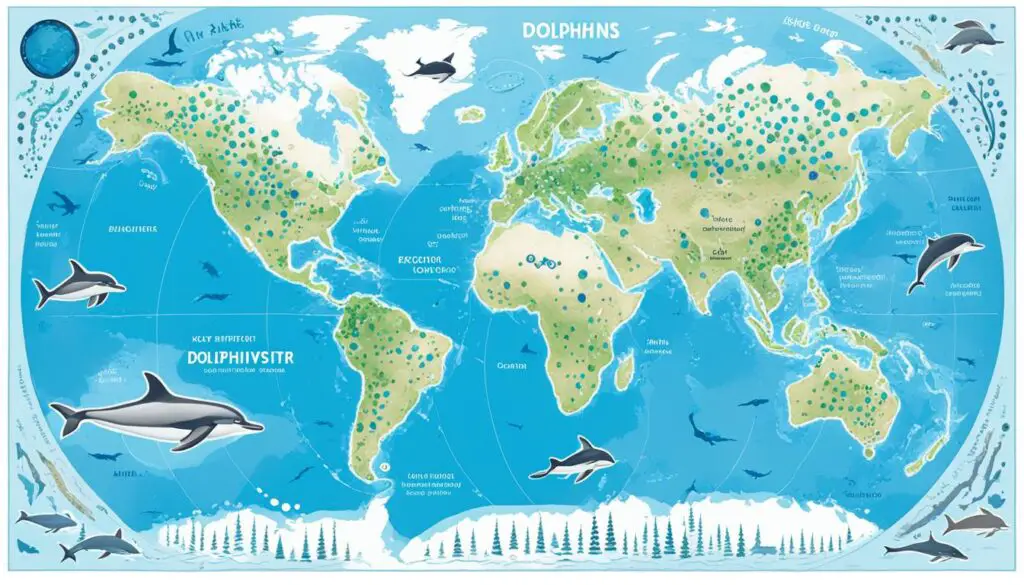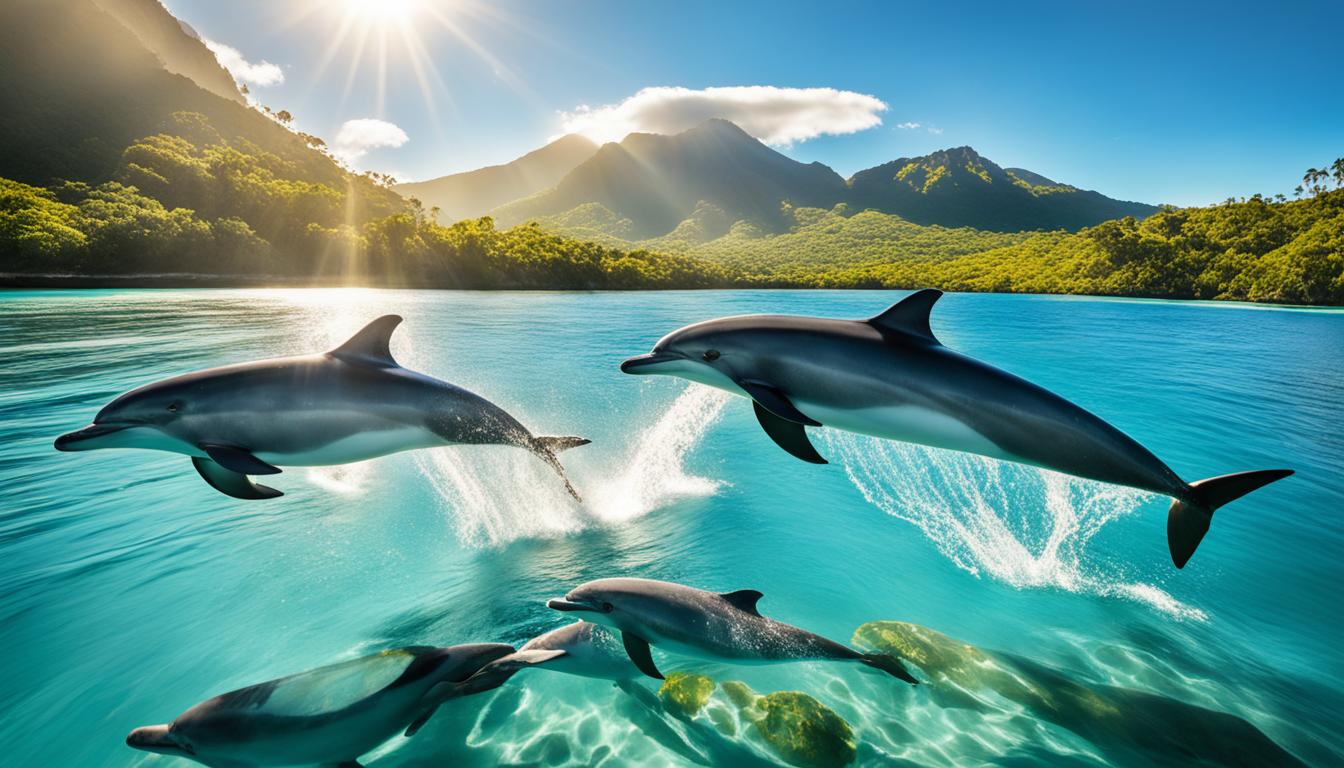Learning where dolphins live helps us appreciate these amazing creatures. Dolphins live in many places, from saltwater oceans to freshwater rivers. They can be found in different parts of the world, showing how well they adapt to various conditions. However, they avoid the cold waters of the Arctic and Antarctic.
Exploring dolphin habitats shows us their social life and how they fit into their environments. Dolphins live in many places, from the coast to deep sea. Their ability to live in so many different places is really interesting.
Dolphin Habitats: An Overview
Dolphins live in many places, each with its own special features. They can be found in both warm and cool waters all over the world. Knowing where dolphins live helps us see how diverse they are.
Types of Dolphin Habitats
Dolphins live in oceans and rivers, showing how well they can adapt. Here are the main types of places they call home:
- Coastal Areas: Dolphins hang out in shallow waters near the shore. They hunt for fish and other sea creatures there.
- Open Ocean: Some dolphins live in the deep sea. They are great swimmers and can go long distances.
- Freshwater Rivers: A few dolphins, like the Amazon river dolphin, live in rivers. This shows how adaptable they are.
Adaptability of Dolphins
Dolphins can change their living places for many reasons. They might move to find food or because of climate change. This ability to adapt is key to their survival in different places.
They can live in coral reefs or rivers, showing how flexible they are. This flexibility helps them thrive in various environments.
Human Impact on Dolphin Habitats
Humans are affecting dolphin homes in big ways. Pollution, overfishing, and destroying their homes are big problems. We need to understand these issues to help protect dolphins.
By using the ocean wisely, we can keep their homes safe. This helps prevent dolphins from disappearing.
Where do dolphins live? Exploring Oceanic Environments
Dolphins live in oceans all over the world. They are found in many places, showing how diverse their homes are. These places help us understand what dolphins need to live.
Distribution Across the World’s Oceans
Dolphins live in both warm and cool waters. Each type of dolphin has its own dolphin living areas. The Atlantic and Pacific Oceans are key places to study them. Dolphins like to be near coastlines and in warm waters full of food.
Temperature Preferences of Different Dolphin Species
Temperature is key for where dolphins live. For example, bottlenose dolphins like it between 50 to 90 degrees Fahrenheit. Places where dolphins reside often match these temperatures, helping them hunt and live well. Changes in temperature affect how dolphins live and move around the world.
Coastal and Shallow Waters
Coastal areas, bays, and shallow waters are home to many dolphins. These places let dolphins interact with humans, like through fishing and tours. While this can help dolphins, it can also be a risk. It’s important to protect dolphin living areas for their future.
Dolphins in Freshwater: Unique River Habitats
Some dolphins live in freshwater, not just saltwater. These river dolphins show us how they adapt to live in rivers. It’s important to know where they live to help protect them.
Species of River Dolphins
There are many types of river dolphins, each suited to its home. Here are a few:
- Amazon River Dolphin: This dolphin lives in the Amazon Basin and is known for its pink color. It can live in murky waters.
- Ganges River Dolphin: This dolphin is found in the Ganges and Brahmaputra rivers. It’s endangered and crucial to its ecosystem.
- Yangtze River Dolphin: Once common in the Yangtze River, it now faces big threats to its survival.
Challenges Faced by River Dolphins
Despite their strength, river dolphins face big challenges. These include:
- Habitat Loss: Trees being cut down and new buildings harm their homes. This limits where they can go and find food.
- Pollution: Chemicals and trash from people hurt the dolphins’ homes.
- Bycatch: Dolphins get caught in fishing gear, which can hurt or kill them.
We need to protect these special places for dolphins. This helps both the dolphins and their homes.
Dolphin Habitat Locations Around the Globe
Dolphins live in many places around the world, showing how well they adapt to different environments. Knowing where dolphins live is key to protecting them. This helps with conservation efforts.
Key Regions of Dolphin Populations
Some areas are home to a lot of dolphins. Dolphins can be found in:
- The waters around Florida, especially the Atlantic coast, where common bottlenose dolphins live.
- The Caribbean Sea, where spotted dolphins are common.
- The Pacific Ocean, home to spinner dolphins and Pacific white-sided dolphins.
- The coasts of Australia, where there are many different dolphins.
Differences Between Pacific and Atlantic Dolphins
Dolphins in the Atlantic Ocean live in different places than those in the Pacific. Some main differences are:
| Characteristic | Pacific Dolphins | Atlantic Dolphins |
|---|---|---|
| Species Diversity | More species, like the spinner dolphin | Common bottlenose and spotted dolphins |
| Habitat Preferences | Like warmer waters in the tropics and subtropics | Live in both coastal and deep ocean areas |
| Population Density | Fewer dolphins in the vast Pacific | More dolphins near human populations on the coast |

Dolphin Habitat Facts and Conservation Challenges
Dolphins are at the top of their food chains. Knowing where dolphins live helps us understand their role in keeping the ocean balanced. They live in both saltwater and freshwater, showing how adaptable they are.
But, they face big threats that need quick action. Climate change changes the ocean’s balance, pollution harms their homes, and some people hunt them illegally. These issues make it vital to protect their homes.
Efforts to save dolphins include:
- Research to monitor dolphin populations and health.
- Legislation aimed at protecting their habitats from destructive practices.
- Community awareness programs to educate the public on sustainable practices.
By tackling these issues, we can help dolphins thrive in their natural spaces. This keeps our oceans and rivers healthy and full of life.
Conclusion: Protecting Dolphin Habitats for Future Generations
Dolphins live in diverse marine environments that are crucial for their survival and the health of our oceans. These places are not just homes for dolphins but also keep the ocean’s balance. They are key for dolphins to breed, feed, and socialize, making it vital to protect these areas.
Thanks to growing awareness, there’s hope for fighting habitat damage. Actions like using eco-friendly practices, supporting habitat restoration, and education can help protect these marine areas. Your support can make a big difference for dolphins and the whole ecosystem.
Protecting dolphin habitats is a job for all of us. By making small changes, we can make a big impact. This will help ensure a safe future for dolphins and keep their homes safe for years to come.
FAQ
Where do dolphins live?
Dolphins live in many places, from saltwater oceans to freshwater rivers. They are most common in tropical and temperate waters.
What types of habitats do dolphins prefer?
Dolphins like shallow coastal waters and deep oceanic areas. Some even live in freshwater, like rivers.
How adaptable are dolphins to their environments?
Dolphins are very adaptable. They change their behavior and where they live based on the environment and food.
What human activities impact dolphin habitats?
Humans harm dolphin habitats with pollution, fishing, and destroying their homes. This can lead to fewer dolphins and even some species going extinct.
Are all dolphins marine animals?
Most dolphins live in the sea, but some, like the Amazon river dolphin and Ganges river dolphin, live in freshwater.
What are the preferred temperature ranges for different dolphin species?
Bottlenose dolphins like temperatures between 50 and 90 degrees Fahrenheit. Other dolphins have different temperature preferences.
What challenges do river dolphins face?
River dolphins face problems like losing their homes to humans, pollution, and getting caught in fishing gear.
How does dolphin distribution vary globally?
Dolphins live in different places around the world. For example, the Atlantic has common bottlenose and spotted dolphins. The Pacific has unique ones like the spinner dolphin.
What can be done to protect dolphin habitats?
We need to protect dolphin homes through research, laws, teaching people, eco-friendly actions, and fixing damaged habitats.
Why are dolphins considered apex predators?
Dolphins are key to keeping the ocean balanced. They are at the top of their food chains in their ecosystems.







